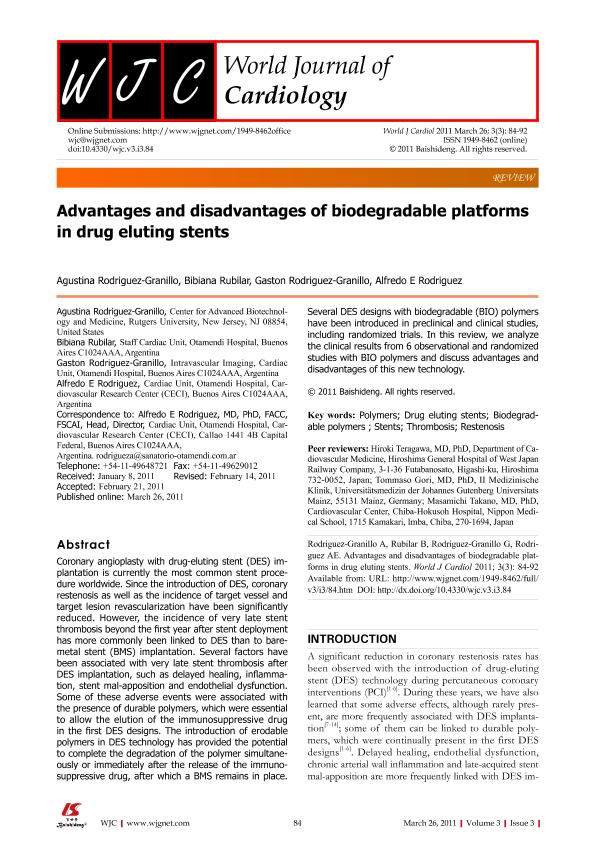Artículo
Advantages and disadvantages of biodegradable platforms in drug eluting stents
Rodriguez Granillo, Gaston Alfredo ; Rubilar, Bibiana; Rodriguez Granillo, Gaston Alfredo
; Rubilar, Bibiana; Rodriguez Granillo, Gaston Alfredo ; Rodriguez, Alfredo E.
; Rodriguez, Alfredo E.
 ; Rubilar, Bibiana; Rodriguez Granillo, Gaston Alfredo
; Rubilar, Bibiana; Rodriguez Granillo, Gaston Alfredo ; Rodriguez, Alfredo E.
; Rodriguez, Alfredo E.
Fecha de publicación:
26/03/2011
Editorial:
Baishideng Publishing Group
Revista:
World Journal of Cardiology
ISSN:
1949-8462
e-ISSN:
1949-8462
Idioma:
Inglés
Tipo de recurso:
Artículo publicado
Clasificación temática:
Resumen
Coronary angioplasty with drug-eluting stent (DES) implantation is currently the most common stent procedure worldwide. Since the introduction of DES, coronary restenosis as well as the incidence of target vessel and target lesion revascularization have been significantly reduced. However, the incidence of very late stent thrombosis beyond the first year after stent deployment has more commonly been linked to DES than to baremetal stent (BMS) implantation. Several factors have been associated with very late stent thrombosis after DES implantation, such as delayed healing, inflammation, stent mal-apposition and endothelial dysfunction. Some of these adverse events were associated with the presence of durable polymers, which were essential to allow the elution of the immunosuppressive drug in the first DES designs. The introduction of erodable polymers in DES technology has provided the potential to complete the degradation of the polymer simultaneously or immediately after the release of the immunosuppressive drug, after which a BMS remains in place. Several DES designs with biodegradable (BIO) polymers have been introduced in preclinical and clinical studies, including randomized trials. In this review, we analyze the clinical results from 6 observational and randomized studies with BIO polymers and discuss advantages and disadvantages of this new technology.
Archivos asociados
Licencia
Identificadores
Colecciones
Articulos(SEDE CENTRAL)
Articulos de SEDE CENTRAL
Articulos de SEDE CENTRAL
Citación
Rodriguez Granillo, Gaston Alfredo; Rubilar, Bibiana; Rodriguez Granillo, Gaston Alfredo; Rodriguez, Alfredo E.; Advantages and disadvantages of biodegradable platforms in drug eluting stents; Baishideng Publishing Group; World Journal of Cardiology; 3; 3; 26-3-2011; 84-92
Compartir
Altmétricas



